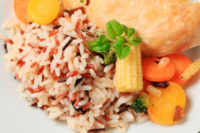Positioning meat and poultry as more than a center-of-the-plate item can potentially generate a bonanza of additional activity for retail and foodservice operators.
The use of such proteins as chicken, beef and pork as a snack, appetizer or side dish can address the needs of the large base of health-conscious consumers seeking new sources of protein, along with those who crave novel eating alternatives.
Making meat and poultry more popular in a variety of roles, however, will demand a change in consumer attitudes and dining habits along with a strong focus by merchandisers on growing activity in each segment, analysts say.
Getting more consumers to snack on meat and poultry, for instance, is difficult as there are easier ways to add protein to diets, says Anne-Marie Roerink, principal of 210 Analytics, a San Antonio-based market research and marketing strategies firm.
“Protein has been hot for many years and continues to be a claim that is driving growth across the store,” she says. “However, meat isn’t necessarily benefitting from that. In snacking, anything from granola bars to various beverages tout the presence of protein in big letters. The only way meat is benefitting is through jerky, which has been strong for many years.”
Yet there are strong opportunities to increase jerky purchases as just 34 percent of adults report buying the meat snacks in the previous three months, “suggesting that this fast-growing segment has more room to grow,” Mintel Group Ltd., a Chicago-based global market research firm, reports in its March 2018 Salty Snacks-US publication.
Pork rinds also have ample sales growth potential as just 20 percent of the 2,000 adult respondents to the Mintel online survey report purchasing the snack option in the prior three months.
Pork is becoming a more prevalent snack, says Jason Menke, director of marketing communications for the Des Moines, Iowa-based National Pork Board.
Major buyer segments include younger and less affluent shoppers from larger households who tend to prefer pork rinds and higher income persons in their mid-40s and older who are more likely to seek pork jerky, he says.
Menke says bacon jerky is especially set for growth as “it is convenient, grab-and-go and users can have bacon flavor without the grease that comes from freshly prepared bacon right out of the kitchen.”
Also driving pork snack activity is the growing base of consumers following low-carbohydrate, high-protein diets, he says, adding that many of those people seek options with unique flavors.
Demographics make a difference
Mintel reports among shopper segments, meat snacks made from premium products such as prime cuts, is high among snack meat purchases among all ages, while younger consumers are more likely than their older counterparts to look for new forms of meat snacks, such as snack bars and trail mixes.
That suggests young purchasers place extra value on portability and the ability to incorporate meat snacks into a wider variety of use occasions, Mintel reports.
A range of product options that enhance shopper convenience also is likely to bolster interest in meat and poultry as a snack, Roerink notes.
“There is a lot of time pressure in today’s society and, as such, ready-to-eat meat and poultry, including chicken tenders or nuggets in the deli, and heat-and-eat protein snacks have a better chance of being integrated than fresh meat,” she says. “Both ready-to-eat and heat-and-eat are growth drivers for retailers as shoppers increasingly mix and match time-saving solutions with their own scratch cooking.”
Meat and poultry snacks also will benefit from the greater interest by many shoppers in animal proteins over plant-based products, says Maeve Webster, president of Menu Matters, an Arlington, Vt.-based food industry research and consulting firm.
“There’s likely far fewer hurdles to getting meat into snack opportunities than as appetizers and side dishes,” Webster says. “Meat-based snacks can easily be positioned as energy boosters and work in a number of other functional positions as long as the portion size is appropriate for the occasion and it’s paired with other ingredients to create a well-rounded item.”
There also will be greater chances for meat and poultry to replace traditional vegetable and carbohydrate selections as side dishes as more consumers incorporate plant-based proteins into their main meals, Roerink says.
“While there is a heavy focus for appetizers on the produce and plant-based side of things, creative recipe management and merchandising can create opportunities for meat and poultry there as well,” she says.
Show shoppers the possibilities
To help persuade consumers to consider new uses for meat and poultry, such as kabobs as an appetizer instead of a cup of soup, merchandisers should promote options in store and across various platforms, include social and mobile media and print, Roerink says.
Marketers also can emphasize the prospect of using leftover meat and poultry from meal kits as next-day appetizers and snacks, she adds.
Meanwhile, chicken — perhaps the most prominent meat and poultry appetizer — also has strong growth potential in the snacking sector because of its healthful elements: taste and value, says Tom Super, senior vice president of the Washington, D.C.-based National Chicken Council.
“While wings, nuggets, tenders, strips and similar products will still be top-of-mind when consumers choose chicken for snacking, the greatest potential for chicken market growth are products that are more convenient for eating on the go and that also can be accepted as hand-held meal replacements,” he says.
It also is important for chicken to be part of the trend of more meat and poultry snacking if it is to continue its decades-long run of increasingly greater consumption, Super notes, adding that chicken is currently a niche player in the shelf-stable meat category.
He says form, flavor, packaging and messaging are key elements for meat and poultry marketers to emphasize if they are to successfully compete in the snack space.
“A look at the displays of these products in supermarkets quickly convinces the food shopper that few, if any, other categories in the store have such creative and diverse arrays of options,” Super says. “A number of these products emphasize the flavor, often a not-so-common one, rather than more directly declaring the form. This marketing approach is good for the category and good for chicken, which can carry a wide variety of flavors and tastes.”
Super adds, however, that while shelf-stable meat bars, sticks, cubes and similar items are gaining traction with consumers, mass distribution and product availability continue to be merchandising challenges.
“Although a number of these products feature chicken or a high percentage of chicken in combination with other ingredients, other meats have so far taken the lead,” he says.
Play the health While flavor and convenience are key attractions for snack food purchasers, nutrition benefits also can be a strong sales magnet, analysts note.
Fifty-two percent of consumers, for instance, indicate they find snacks that merchandisers list as high in protein as being very appealing, reports Technomic Inc., a Chicago-based food industry research and consulting firm, in its 2018 Snacking Consumer Trend Report.
“These proteins help position snacks as filling options that will hold off hunger and potentially replace meals,” says Charles Winship, Technomic senior research analyst.
In addition to snacks, chicken, beef and pork also can add protein, flavor and craveability to common meal starters, such as salads, nachos and quesadillas, he says.
Chicken strips and wings are the leading meat and poultry appetizers on menus because the items adapt well across meal parts and provide operators with menu flexibility, Winship says.
In addition, bacon is the most prevalent meat or poultry in restaurant side dishes and has a strong presence in such options as loaded hash browns, baked potatoes and vegetables, Technomic’s Ignite Menu Database reveals.
“Just as vegetables are finding a new role at the center of the plate, proteins are finding new roles in sides,” Winship says.
In fact, 35 percent of consumers indicate they’d like restaurants to offer more meat-focused side dishes for lunch and dinner, according to Technomic’s 2017 Starters, Small Plates & Sides Consumer Trend Report.
A host of merchandising challenges
Constraining the popularity of meat and poultry as a side dish, however, is a lack of innovation in the category, Webster says, noting meat sides are primarily part of breakfast and rarely important during other dayparts.
Significant creativity in non-meat sides or sides that limit the role of meat also create growth obstacles for meat and poultry merchandisers, she says.
“The hurdle for protein-based sides is largely relevance and appropriateness,” Webster says. “To add a meat-based side to a meat-based dish becomes a hard sell given many consumers are either limiting their consumption of animal proteins, trying to increase their consumption of other items for health reasons and typically seeking to avoid significant redundancy when it comes to consumption outside of the breakfast daypart, where protein sides are more traditional.”
A focus on produce innovation, she says, also makes the positioning of chicken, pork and beef as a snack, appetizer or side dish more challenging.
“It’s not that they are disappearing or will no longer play a role, but the portion sizes are shrinking and the meat and poultry are playing less of the starring role in each category,” Webster says.
While animal proteins are gradually becoming more popular appetizers, she says meat and poultry “often take a back seat to produce and are playing more of a supporting role for textural, visual and flavor contrast than anything else.
“When there are far more interesting options available that are pushing proteins to the sidelines, it’s harder to go back to more ‘common’ appetizers that had meat as the main focus.”
Pricing, meanwhile, also can be a major obstacle for merchandisers looking to increase the use of meat and poultry as a snack, side dish or appetizer, with the greatest impact occurring at foodservice locations, Webster says.
“Consumers are trying to reduce (spending) away from home, so often the first categories for elimination are a la carte sides and/or appetizers,” she says. “Plated sides are less impacted but those are rarely meat-based. And a la carte sides that are doing well tend to be far more vegetable-based or exclusively produce.”
Datassential, a Chicago-based market research firm, reports pricing volatility for meats other than poultry is among the largest challenges to including protein selections on restaurant menus, while shopper ignorance about the prospect of using meat and poultry as a snack, side dish or appetizer has an impact on sales at supermarket meat departments.
Winship says the use of proteins usually leads to higher prices, and that could be a problem given consumers’ demands for affordability when buying snacks, starters and sides.
To help overcome such challenges and enhance the value perception of meat and poultry, merchandisers should emphasize the benefits proteins add to side dishes and snacks in terms of portions and craveability, he says.
Younger shoppers, for instance, are driving demand for breaded chicken appetizers, such as boneless wings, chicken strips and popcorn chicken, because the items are craveable, shareable and easily customizable with sauces, Winship says. NP
Rollouts add pizzazz to the meat and poultry snacking segment
The launch of newer options is helping to create more vibrancy in the meat and poultry snack food sector.
Recent rollouts include Steak Bites from Minong, Wis.-based Jack Link’s Protein Snacks. The handheld item comes in a one-handed, tear-and-eat snack pack that Jack Link’s is positioning as a high-protein (17 grams per pack), low-calorie (110 calories) option. Flavors include Original and Teriyaki.
Jack Link’s in 2018 also began marketing Cold Crafted Linkwich, a new line of fresh, refrigerated, hand-held, grab-and-go premium cured meat and cheese products that have 15 grams of protein and 1 gram of carbs per pack. It was inspired by the eating habits of busy families, the company says. Varieties include Colby Jack and Hard Salami, Pepper Jack and Genoa Salami and Cheddar and Hard Salami.
Other recent Jack Link’s snack launches are Smoke House Beef Sausages with a hickory and Applewood smoked finish that is available in Original and Hot and Spicy varieties; lunchbox-size Meat Sticks available in two beef flavors, Original and Pepperoni, along with Original Turkey; and the Beef Steak Strips snack bar available in Original and Teriyaki flavors.
In addition, Livingston, Calif.-based all-natural chicken producer Foster Farms in October launched Bold Bites, an on-the-go chicken snack the company reports was inspired by bold flavors.
The fully cooked ready-to-eat breast pieces are sold in single-serve pouches and contain 15 grams of protein per serving. Varieties include Cajun, Chile Verde, Korean BBQ, Caribbean Jerk and Parmesan Garlic.
A world of potential for animal-based proteins
Opportunities are ripe for expanding the use of meat and poultry as a snack, appetizer and side dish.
With many consumers looking for newer eating experiences, merchandisers that offer unconventional offerings will be in position to boost shopper interest and purchasing activity, analysts say.
“Half of consumers reach for meat sticks, jerky or appetizer/entrée foods as a quick bite,” according to Datassential, a Chicago-based market research firm.
In a Datassential survey of 1,426 meat eaters, 40 percent of respondents indicated an interest in gourmet meat snacks, 38 percent in nontraditional meat jerkies and 29 percent in meat protein bars.
“With consumers reporting that they snack from four to five times a day, watch out for new snacking opportunities,” Datassential reports. “From cooked chicken breasts to bites and all types of jerkies and varieties of chips, meat and seafood offer plenty of opportunity for snacking innovation.”
Datassential shows appetizers and side dishes are generating some of the largest increases for meat and poultry options on restaurant menus, with beef and pork each growing 15 percent from 2013 through 2017. Datassential attributes part of the boost to interest in protein as an overall healthy selection along with the rise in special diets, such as Whole20 and Paleo, which emphasize animal proteins.
Chicken, meanwhile, is the most-menued protein and continues to grow on restaurant appetizer and side dish menus, which includes its use on pizza and flat breads, Datassential reports in its 2017 SNAP! Keynote Report: Meat and Poultry.
In addition, bacon is growing across nearly all menu parts, and most significantly in appetizers, Mexican dishes and salads, and chefs “are still discovering new ways to use bacon in appetizers and beyond,” Datassential states.
Where’s the beef?
The versatility of beef, meanwhile, also makes it easy to include the protein as an ingredient in snacks, side dishes and appetizers, says Peter Rosenberg, corporate chef for Wooster, Ohio-based Certified Angus Beef.
Possibilities include the use of chuck flap beef satay for appetizers and eye of round Bresaola for snacking, he says.
Rosenberg adds that side dish options include short rib ravioli and deep-fried Brussels sprouts with beef bacon.
Rosenberg says the trim or unused portions of a roast that consumers buy as a center-of-the plate dish can be heated and easily shredded for inclusion in an appetizer, sandwich or barbecue application.
“Using the beef in the second dish saves time in the kitchen, making that meal easier than the first,” he says. “Beef’s value as an ingredient can exceed its cost when used as a menu component. Beef can be used a second night in pastas, soups, appetizers and other recipes.”
Frozen and heat-and-serve options such as pork meatballs as appetizers also provide growth opportunities for meat and poultry merchandisers, says Jason Menke, director of marketing communications for the Des Moines-based National Pork Board.
Offering such selections is important as fresh pork can create convenience issues for time-stressed consumers because of its preparation requirements, he says.
Retail operators also can potentially benefit by offering such selections as value-added cubed pork, cubed bellies and strips of pork loin that will not require the in-home cutting of boneless or bone-in chops, Menke says.
“To succeed as a growth driver, a product must meet basic needs,” says Anne-Marie Roerink, principal of 210 Analytics LLC, a San Antonio-based market research and marketing strategies firm. “For consumption occasions beyond dinner, that means addressing on-the-go immediacy and convenience issues.”











